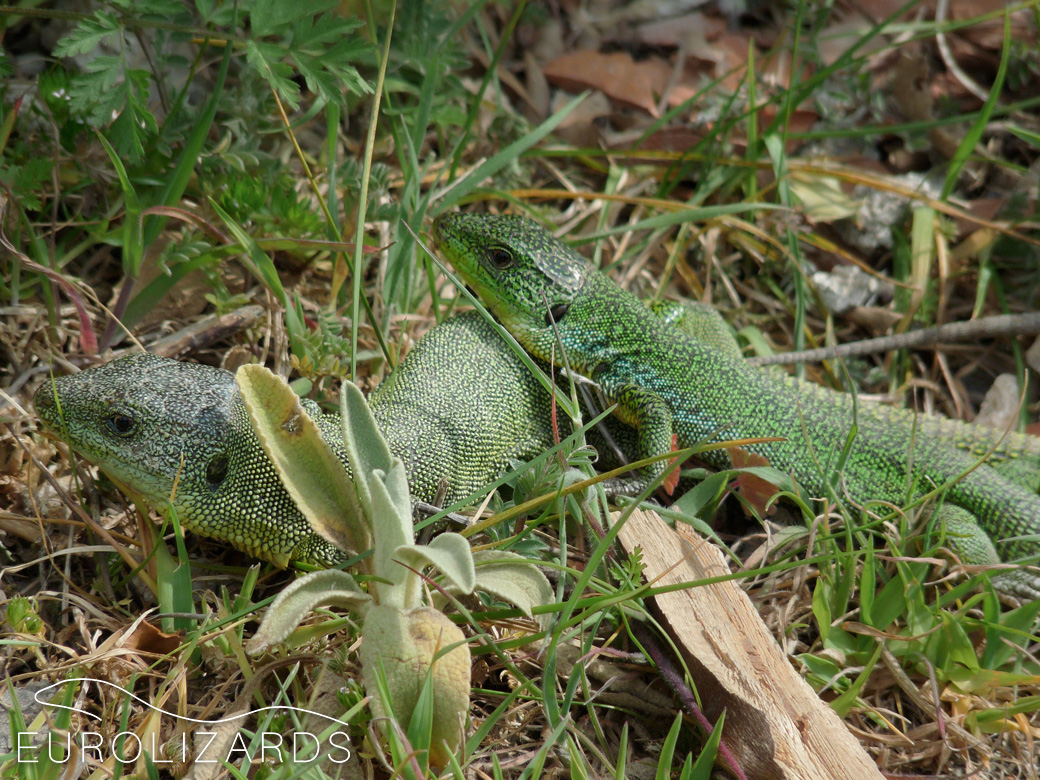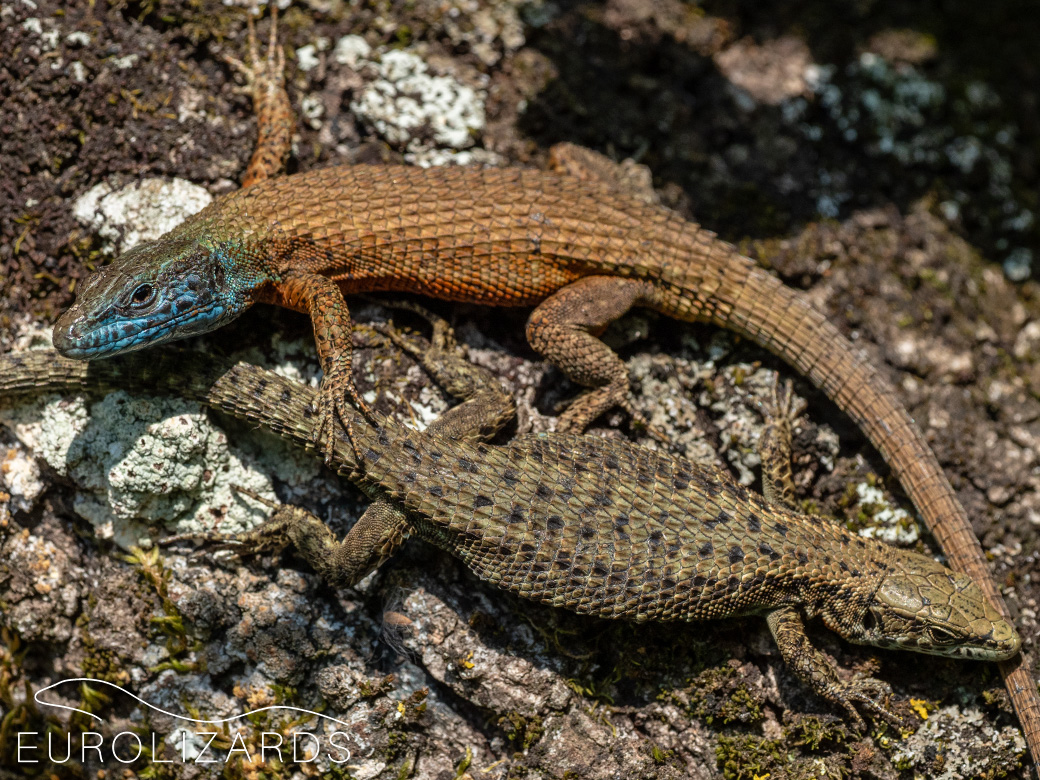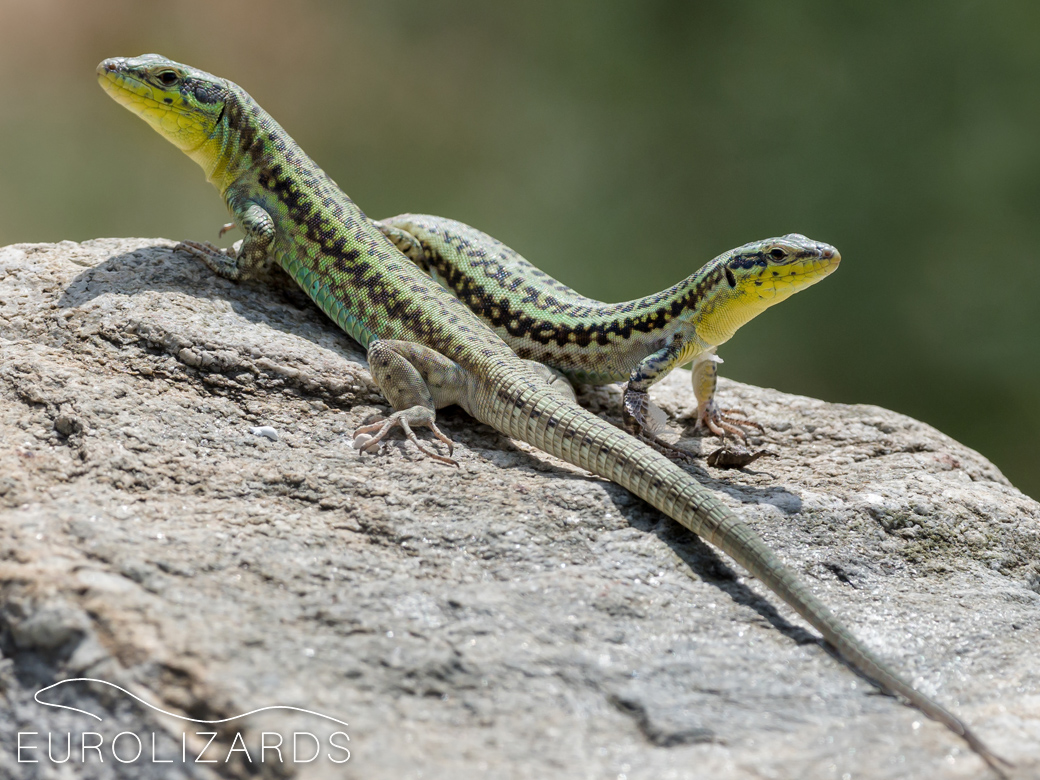Pair behavior of small Lacertids (publ. 04.2020)
It is widely known that Green Lizards of the genus Lacerta tend to extensive “cuddling” during mating season and it seems obvious that these species show some kind of “pair behavior” beyond mere copulation. But what about small Lacertids (e.g. genus Podarcis)? Do they show similar “pair bond”? It seems that surprisingly little is known about this. For sure, the small European Lacertid species are well explored regarding external characters, morphology as well as genetics. But we do not know what happens inside their tiny heads. However, gaining insights into this would be highly interesting. As these lizards somehow could be regarded as prototypes of terrestrial vertebrates, they even could provide information about the origin of "higher developed" vertebrates’ behavior.

Small Lacertids’ life: determined by antisocial behavior and violence?
At the first glance, the small Lacertids’ social behavior is widely regarded as rudimentary and rude: a solitary lifestyle, their sporadic social contacts limited to territorial aggression between males, fight for food or – not less violent – short, rape-like copulation. Not very romantic. And even in case of lizards “peacefully” basking together, it is put under question whether this indicates some kind of social relationship or if they just accidentally chose the same spot, e.g. warm substrate, for thermoregulation (reptile keepers may be familiar with several specimen basking together under the heating lamp).
Territoral violence in Psammodromus algirus (Large Psammodromus)
Short and effective copulation in Podarcis muralis (Common Wall Lizard)
Rape-like copulation in Podarcis vaucheri (Vaucher's Wall Lizard)
Joint thermoregulation: indication of social relationship or just accidentaly using the same substrate?
So, does small Lacertids‘ social behavior amount to nothing more than territorial violence, dull competition on food and reproduction, overshadowed by predative pressure? This is what one might expect from these “primitive" creatures which even do not care about their offspring, as even Pliny the Elder knew that lizards deposit their eggs “but do not breed, as they lack the memory to remember the place of oviposition” (free translation from LENZ, H. O. (1856): „Zoologie der alten Griechen und Römer“, p. 428.).
These rather disillusioning findings raise two questions:
- Does small Lacertids’ behavior comprise social interaction beyond straight aggression?
- Does “pair bond” occur in small Lacertid species?

Small Lacertids‘ social life: The toolbox
A substantial part of social interaction between Lacertids seems to be based on chemical stimuli (pheromones) and a couple of interesting studies have been conducted on this (e.g. GABIROT et al. (2013), FONT et al. (2012)).
Furthermore, Lacertids have a variegated toolbox for of signals which they use for communication between sexes:
- Mating colors as a general visual signal indicate the males’ willingness to reproduce. It could be a signal for females as well as for competitors.
- Tongue flicking should be seen as an interaction with chemical stimuli but possibly not as an optical signal.
- Inflating throats in males can be interpreted as display, which they also show in territorial conflicts.
- Females may show some shaking or at least lifting of legs. FONT et al. 2012 (2) suppose that fast foot shakes are predator-elicited and serve as deterrent function. However, moving or lifting legs also seems to play a role as an optical signal between sexes.
- Seeking or tolerating body contact (using a forefoot or the whole body) may produce tactile signals. Putting a forefoot on the partner’s body could be interpreted as a friendly gesture, but this is highly speculative. However, body contact at least indicates some kind of “familiarity” (i.e. the absence of stress).
Anecdotal vs. experimental observations
Our own observations about lizards’ pair behavior are based on sporadic encounters during field trips. Therefore these anecdotal observations provide limited explanatory power compared to experimental or empirical studies. However, experimental studies (e.g. putting lizards in a tank) bear the risk of biasing the lizards’ behavior. Watching lizards in their natural habitats allows to observe their full range of optical signals. Using tele-lenses for photography minimizes the photographer’s impact on lizard behavior. Hence, our photo documentation may provide complementary information to scientific studies.
Lizard pair behavior: blocking male aggression and reducing female stress level
The following photo sequences illustrate what small Lacertids are able to do with regard to pair behavior (our exemplary documentation refers to the genus Podarcis - however, similar behavior patterns may occur in other genera). Remarkably, the most interesting interactions between males and females in our documentation did not occur in direct context of copulation, some of them happened several weeks later in fact.
Podarcis erhardii (Aegean Wall Lizard), GR / Naxos, 01.04.2016: A quick „friendly gesture” as a first indication for pair behavior?
Podarcis erhardii, GR / Serifos, 20.04.2018: Although copulation occured a few weeks ago, occurence of pairwise basking is striking.
Podarcis erhardii, GR / Serifos, 18.04.2018: Female calms down male's advances.
Podarcis thais (Eastern Peloponnese Wall Lizard), GR / Peloponnese, 15.04.2019: Pair bond does not necessarily imply monogamy.
Podarcis erhardii, GR / Astakida, 28.05.2019: Applying the complete behavorial toolbox.
Podarcis peloponnesiacus, GR / Peloponnese, 29.05.2017: Male "guards" female to its outlook.
It appears that small Lacertids are able to perform some kind of „pair bond“, at least during mating season – as far as we know, this fades out in early summer when the lizards return to their rather solitary lifestyle. Their toolbox of chemical, optical and maybe tactile signals seems to be adequate to temporarily suppress or canalize the males’ aggressive behavior to a certain degree.
Conclusions
It turns out that small Lacertids’ behavorial toolbox contains a variety of signals and stimuli. Handling these requires some remarkable skills:
- Recognition of a partner: The lizards need to able to distinguish between their partner and other lizards for effective use of signals.
- Episodic memory: The recognition needs to be linked to memory, e.g. when a male appears, the female has to evaluate whether this very specimen means a threat or not. This implies even some degree of “familiarity” or at least some habituation. Otherwise, staying close to a male over several weeks would cause permanent stress for the female.
- Situational ability to send adequate signals: Interacting with a partner, the lizards need to choose the right signals – this may be crucial, in particular for canalizing male aggression.
- Ability to process signals and react adequately: This seems trivial at the first glance. However, a male at least has to realize if the female is willing to copulate or not. Otherwise, aggressive action would likely jeopardize pair bond.
At first, pair behavior in species without brood care seems counter-intuitive as it could be expected that the males will try to copulate with as many females as possible. Nonetheless, our findings indicate that pair behavior does not necessarily imply monogamy. Hence, pair bond will not necessarily conflict with optimizing reproductive success.
But what may be the evolutionary drivers for such complex behavior patterns?
- First, it could be argued that pair bond makes sense at least until oviposition. This would apply only in case of the male “guarding” the female and doing so, optimizing its reproductive success. Being flight animals, lizards wont defend their partners against predators, of course, but staying together might increase safety anyhow, as four eyes see better than two.
- Second, some “mate guarding” could also increase the males’ reproductive success, in particular when it comes to holding rivals away. This would at least make sense in case of long reproduction periods with females laying more than one clutch. Beyond this, we have no information to what degree the same specimen will copulate in subsequent seasons.
- Third, females may benefit from staying close to a “partner” which keeps away other males. As in general, interactions between sexes are characterized by a high level of aggression, this aspect of security may be important for females. It may simply reduce stress for females. This argument could particularly apply during pregnancy when females are unwilling to mate.
It seems obvious that the lizards have learned to use their skills and doing so, successfully canalizing male aggression – at least temporarily. This raises the question if small Lacertids are “smart animals”. One could legitimately object that the major part of lizard behavior is controlled by mere bio-chemical processes. However, this argument is somehow unsuitable for assessing intelligence as basically all cognitive processes are based on bio-chemistry. Even in a pure scenario of chemical stimuli and triggers, the lizard’s central nervous system needs to be able to process different signals, match them with memory and transfer them into adequate action – a remarkable performance of such a small head!
The analysis of Lacertid pair behavior has revealed a set of effective social skills. This illustrates that the fundamental mechanisms for “pair bond” as we know it from highly developed mammals
and birds may be inherited from "primordial" vertebrates which could have been similar to lizards.

Literature
GABIROT, M. & LÓPEZ, P. & MARTIN, J. (2013) - Female mate choice based on pheromone content may inhibit reproductive isolation between distinct populations of Iberian wall lizards. - Current Zoology, 59 (2): 210-220.
FONT, E. & BARBAROSA, D. & SAMPEDRO, C. & CARAZO, P. (2012) - Social behavior, chemical communication, and adult neurogenesis: Studies of scent mark function in Podarcis wall lizards.
- General and Comparative Endocrinology, 177 (1): 9–17.
FONT, E. & CARAZO, P. & PÉREZ I DE LANUZA, G. & KRAMER, M. (2012) - Predator-elicited foot shakes in wall lizards (Podarcis muralis): Evidence for a pursuit-deterrent function. -
Journal of Comparative Psychology, 126 (1): 87-96.

EUROLIZARDS - The Home of European Lizards! © Birgit & Peter Oefinger












































